Cartones
Carranza’s early cartones
As metallic coinage disappeared in the area controlled by the Constitutionalists the lack of small change became so serious that they issued pasteboard cartones. Two of Carranza's decrees were made whilst he was in Chihuahua: on 10 April, at Ciudad Juárez, he authorised (decree núm. 24El Constitucionalista, 14 April 1914) an additional 800,000 pesos ($300,000 in five centavos and $500,000 in ten centavos notesThese were 5c Series C - H, each numbered 1 - 1000000: 10c Series B - F, each numbered 1 - 1000000) and on 6 May, at Chihuahua (decree núm. 26El Constitucionalista, 7 May 1914), another one million pesos, $400,000 in five centavos and $600,000 in ten centavosThese were 5c Series I - P, each numbered 1 - 1000000: 10c Series G - L, each numbered 1 - 1000000.
Villista cartones
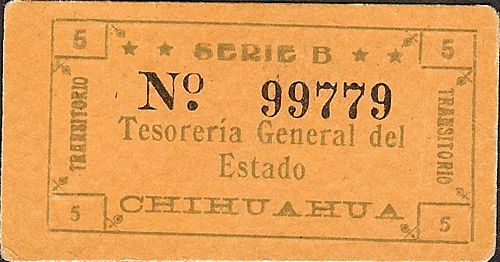
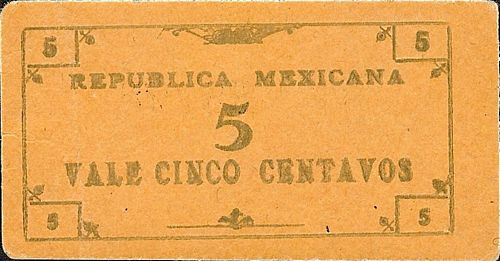
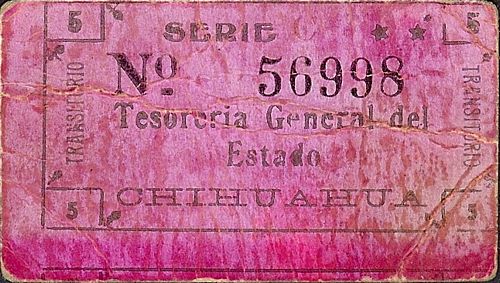

| Series | from | to | total number |
total value |
||
| 5c | A | |||||
| B | includes number 99779 | |||||
| C | includes number 56998 |
These 5c cartones were issued as a consequence of the shortage of small change caused by Villa declaring Carrancista currency null and void in early 1915 (see Villista currency policy in Chihuahua).
On 4 April 1915 the Presidente Municipal of Parral reported that the local Banco del Estado de Chihuahua was refusing to accept Carrancista notes unless they were revalidated. He asked Governor Fidel Avila for instructions on the matter and on the next day he was reporting that the news that Carrancista money was effectively banned had caused great alarm. On 7 April 1915 he was asking whether Ejército Constitucionalista notes and the 5c, 10c and 20c cartones were includedAMP, Gobierno, Jefatura Política y Presidencia Municipal, Libros Minutarios, AL12-13-000-103. By the next day he was able to inform the public that the government had decided that the cartones could continue circulating whilst it arranged its own cartones which would be available within a few days, and that the Ejército Constitucionalista were considered CarrancistaAMP, .
By May 1915 it was reported that the Departamento de Hacienda in Chihuahua had been collecting in the cartones for over two months and replacing them with newly-minted 1c and 5c copper coins. It had announced that after a reasonable period any outstanding cartón would be considered voidThe Mexican Herald, 13 May 1915.
On 17 April 1915 the government sent $1,000 in 5c cartones to Parral, and on 4 May arranged to send another $1,000. However, neither consignment had arrived by 6 May 1915. By 18 May they had arrived, but few exchanges had been made because businesses were proving difficult AMP, Gobierno, Jefatura Política y Presidencia Municipal, Libros Minutarios, AL12-13-000-103. By 27 May the Recaudación de Rentas still had not exchanged any cartones, refusing to accept the Carrancista ones. On 4 June the Presidente Municipal reported that the few Carrancista cartones in existence (at most $5,000) were in the hands of the poor and asked whether they could be exchanged before their circulation was suspended. By 25 July he was reporting that the lack of small change was very critical and demanded that the Recaudación de Rentas put more into circulationAMP, Gobieno, Jefatura Política y Presidencia Municipal, Libros Minutarios, AL12-13-000-103.
Constitutionalist cartones in Chihuahua
In 1916 the Constitutionalists in Chihuahua issued cartones to cover a shortage of small change. There were two values, 10c on green pasteboard and 20c on brown or yellow/black pasteboard.
10 centavos
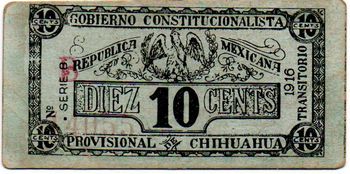
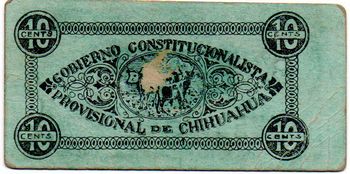

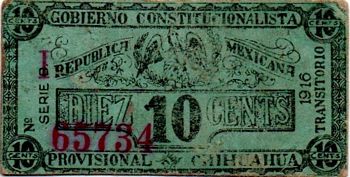
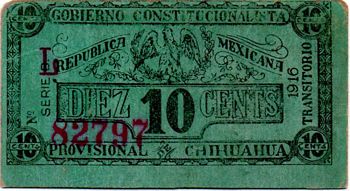
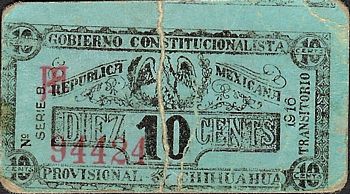


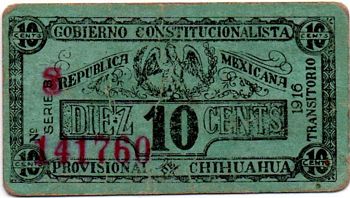
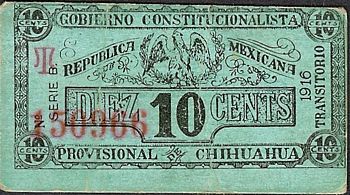

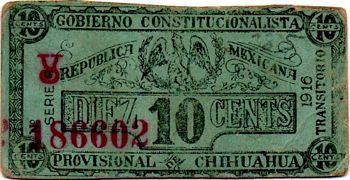
| Series | sub-series | from | to | total number |
total value |
|
| B | B | includes number 4055 | ||||
| C | includes number 19635 | |||||
| I | includes number 65734 | |||||
| L | includes number 82797 | |||||
| M | includes number 94424 | |||||
| O | includes number 104934 | |||||
| R | includes number 61078 | |||||
| S | includes number 141760 | |||||
| T | includes number 150966 | |||||
| X | includes number 180266 | |||||
| Y | includes number |
20 centavos
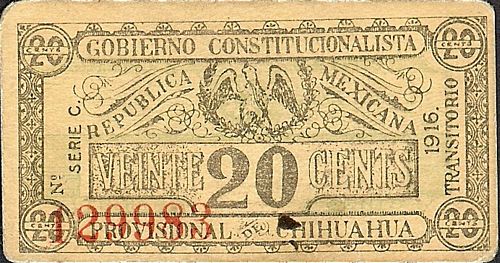
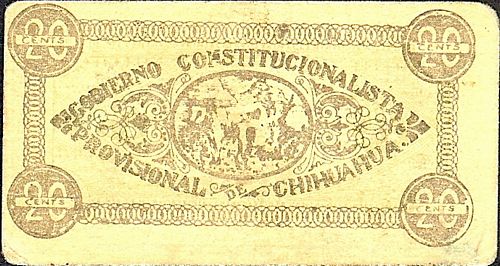
| Series | from | to | total number |
total value |
|
| C | includes numbers 50890 to 137539 |
On 6 October 1916 the Presidente Municipal of Chihuahua, Julio Ornelas, noted that people were complaining that businesses were refusing to accept these cartones and advised that they were legal tender up to the sum of twenty pesos in any transactionAMC, Fondo Revolución, Seccion Justicia, Año 1916, caja 2, exp.7.
